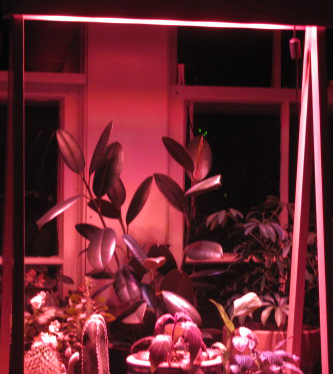
A recurring theme I hear from those who are truly enthusiastic about the concept of growing their own food indoors is the general vision of an automated system which grows food for you. I believe every gardener shares the common affliction of wanting to grow a certain plant that doesn’t grow naturally where they live. One of the many joys of living when we do, is the technology does exist to allow you to grow a citrus tree in your hallway if you want to. Seasoned gardeners have generally reigned in this affliction; realizing that just because it is possible, doesn’t mean it is practical. The following is for the enthusiastic indoor urban gardener who is new to the task. To relay every nuance of an indoor food garden doesn’t seem possible so I’m going to relay just one that is often overlooked: night and day to indoor fruiting plants.
Until the advent of LEDs several years ago, all plant light sources had at least one thing in common, heat. The LED grow light provides an opportunity to add light without adding heat. A well-designed array can last up to 100,000 hours and run on as little as 9 watts specifically, because the design eliminates heat. But the lack of heat can cause some problems, so we need to learn how to garden without heat. The heat from a traditional grow lamp not only warms up the room and root zone but also provides a nighttime versus daytime differential. A general rule of thumb is that plants are expecting a day temperature about 10-15° F higher than the night temperature. If there is no natural lighting (sunlight) and you switch out your HID for LED the light source is no longer taking care of the differential.
When you grow under LEDs turning off the light has almost no effect on the temperature. The concept isn’t especially important for the average house plant but when we branch out to food crops indoors, these differentials can have a serious impact on the end result and for some varieties are critical at certain stages of development. If you are conscientious about conserving electricity you would likely keep your air conditioner set no lower than 78°F and your heat no higher than 68° F. Many fruit bearing plants are going to like the temperature warmer or colder than the conscientious thermostat adjuster can accept.
There are steps you can take to grow food indoors without putting your comfort level at the mercy of your plants. Some plants like mint, thyme, or basil will flourish at the same temperatures we do if, you can accept that when the room is cooler, they will grow slower. A good starting point is to see where you are by checking the temperature of your root zone; this is the most important temperature reading you can take and will likely be 10-15 degrees colder than the air around your plants. If your choice includes a plant with special temperature requirements that are below the temperatures within your home, consider sowing your seeds to coincide with the natural occurrence of these temperatures outdoors. If you need to raise the temperature 10-20° a simple heat mat could be the solution. The goal of any indoor gardener is to come as close as possible to the environment nature provides under ideal conditions.
Choose your plants wisely. The ability to provide the special requirements for the plants you choose can make the difference between an indoor garden that brings life to your living area, and the indoor garden that crushes your enthusiasm for gardening. Just because we cangrow tomatoes on our coffee table- doesn’t necessarily mean we should. As Dale Carnegie once wrote, “Flaming enthusiasm, backed up by horse sense and persistence, is the quality that most frequently makes for success.”
Angela Lundmark enjoys gardening outdoors and indoors and freelance writer.
Related Articles & Free Email Newsletter
5 Indoor Plants that Require No Time or Energy
Don’t Try to Fit LEDs into an HPS Box



Comment here